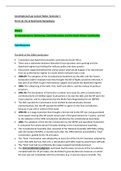Class notes
PBL2000 (Constitutional Law) Semester 1 Notes
- Course
- Institution
These are complete, comprehensive, and understandable lecture notes for semester 1 of the PBL2000 - Constitutional Law course. The lecture notes include content summaries, covering: the introduction, the legislature, the executive, the judiciary, chapter 9 institutions, and multi-level government. ...
[Show more]



